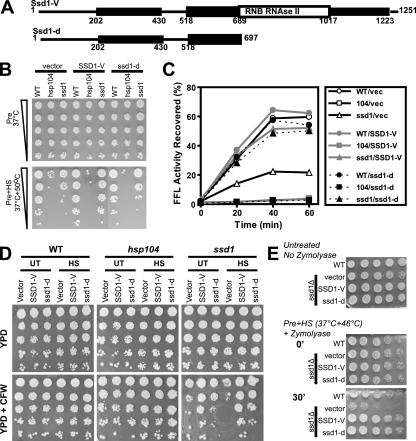FIG. 4.
Functional differences between the polymorphic variants of SSD1. (A) Schematic diagrams of the expected protein products (namely, Ssd1-V and Ssd1-d) from the two alleles of SSD1. (B) Differences between the ability of the two allelic variants to confer thermotolerance were examined by comparing the growth of cells with pretreatment alone (Pre) or with a lethal heat shock (Pre+HS). (C) The ability of each Ssd1 variant to restore protein disaggregation in hsp104Δ and ssd1Δ cells was examined by monitoring the reactivation of FFL-GFP after a nonlethal heat shock. WT, wild type; 104, hsp104Δ mutant; ssd1, ssd1Δ mutant; vec, empty vector; SSD1-V, pPL092; ssd1-d, pPL093. The ability of each Ssd1 variant to support cell wall remodeling after heat shock was examined by monitoring the sensitivity to CFW before and after nonlethal heat shock. (D) The ability of wild-type (WT), hsp104Δ, or ssd1Δ cells to grow on YPD plates without (YPD) or with 50 μg/ml CFW (YPD+CFW) was examined. Cells were spotted after no treatment (UT) or after a heat shock (HS; 37°C for 30 min and 46°C for 30 min). (E) Cell wall remodeling after heat shock was examined by sensitivity to zymolyase. Wild-type cells (control) or ssd1Δ cells carrying empty vector or each of the two alleles (SSD1-V and ssd1-d) were subjected to nonlethal heat shock (37°C for 30 min and 46°C for 30 min), followed by treatment with zymolyase for 0 or 30 min. All cells grew similarly when no treatment was given (top). After the nonlethal heat shock, ssd1Δ cells lost viability after treatment with zymolyase for 30 min. Both SSD1-V and ssd1-d alleles fully suppressed the sensitivity of ssd1Δ cells to zymolyase.

